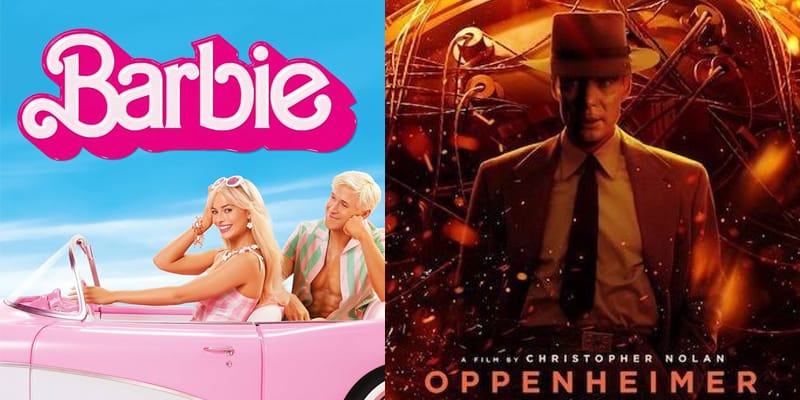First-year law student Shinelle Leo looks at last year’s cultural film phenomenon

No matter where in the world you were in the summer of 2023, it was impossible to escape the ‘Barbenheimer’ phenomenon. Whilst one movie is a pink-themed, post-modern take on a blonde doll navigating the human world, the other is a pensive and striking biopic based on the ‘Father of the Atomic Bomb’. Many may have watched both purely for their love of cinema, however keen legal heads would have been curious to consider the legalities preceding the films. Both pictures have a fascinating legal framework covering intellectual property (IP) protection and historical legislation.
Trademarks, trade secrets and Mattel
According to BrandFinance, the Barbie brand has a market value worth USD$701 million in intellectual property. It is well-established that their owners, Mattel, intend to protect all Barbie creations. Mattel has developed the IP profile for Barbie by registering trademarks and copyright protection globally including 23 registered trademarks in the EU and over 30 registered in the UK, including the name ‘Barbie’, variations of the logo, Barbie’s iconic boyfriend ‘Ken’ and now, trademarks for the phrases ‘Kenough’ and ‘Mojo Dojo Casa House’.
The chronicles of ‘Barbie pink’
Mattel owns a range of trademarks for different features of Barbie. One irrefutable feature of not only the brand itself, but also the movie, is the substantial usage of the colour pink including the introductory song being named ‘Pink’. Although theoretically impossible to trademark an entire colour, Mattel does have (unofficial) protection for a specific shade of pink- Pantone 219C. This has been consistently used when portraying Barbie and has arguably achieved ‘acquired distinctiveness’. This is where, for a trademark to be claimed, it has to have become ‘distinctive’ resulting from its use in the market to the extent that consumers recognise the trademark in relation to a particular good or service. Mattel has attempted to register a trademark for the ‘Barbie Pink’ with the US Patent and Trademark Office in over 100 categories — although this is yet to be officially trademarked.
The acquired distinctiveness of ‘Barbie pink’ was further argued by Mattel when they sued Rap Snacks, alleging that they infringed on the trademark rights of Barbie. This was not just for Rap Snacks using the name ‘Barbie’ in ‘Barbie-Que Chips’, but also for using their famous pink on its packaging. Mattel argued that this would cause consumers to associate the defendant’s products with the Barbie brand. However, the case was ultimately dismissed as Rap Snacks agreed to stop selling the product.
A Barbie girl in a Barbie world?
Mattel is also keen to protect the usage of the name ‘Barbie’ being used by other parties. In 1997, they sued the band Aqua for their song ‘Barbie Girl’ as they published the song without gaining Mattel’s prior consent to use the doll’s name. As the song became increasingly popular, Mattel sued MCA Records, Universal Music International, and other parties involved in distributing the song. The lawsuit claimed trademark infringement and dilution; dilution refers to the use of a trademark that is relatively similar to an existing famous mark causing consumer confusion.
The trial Court held that the song was unlikely to diminish the Barbie trademark. According to the Court, it was unlikely to allude consumers into believing that Mattel was affiliated with the song as the song was a parody, giving it protection under the First Amendment. Ultimately, when Warner Bros released the Barbie movie in 2023, Mattel prioritized not only the licensing of the Barbie marks, but also the usage of the quality of these marks’ by third parties.
Barbie vs Bratz: the trade secrets saga
One unfamed IP concept is that of trade secrets which refers to confidential information being bought and sold. In 2004, Mattel sued for misappropriation of their trade secrets by MGA (the brand that created Bratz) as they claimed one of their former doll designers had developed the idea for the Bratz dolls and allegedly taken this idea to MGA using the insider knowledge they had gained of the Barbie ecosystem. Mattel won the trial in 2008 and was awarded $100 million in damages which was then appealed by MGA, who went on to win the appeal. They claimed that it was Mattel who had allegedly misappropriated MGA’s trade secrets by committing corporate espionage on their marketing plans and planned product concepts. MGA received $85 million in damages, at which point both sides had ended up spending over $100 million in legal fees.
Want to write for the Legal Cheek Journal?
Find out moreFilm rights to Barbie
With regard to the film, there exist film rights which are rights under copyright law that allow a film-maker to create a film based on an existing property or idea. Entertainment mogul, The Warner Brothers Company currently enjoys the film rights to Barbie as they were the ones to pursue the film’s creation. Prior to this, Sony intended to create the Barbie movie for release in June 2018. However, their rights expired in in 2019 as writers Amy Schumer and Kim Caramele were undecided on the direction the movie should take. This is where the Warner Brothers stepped in to push forth the live-action film which generated for them a $1.5 billion profit.
Mattel’s Barbie brand is protected by a raft of IP rights. It is evident that with the heightened attention to the Barbie brand following the release of the Barbie movie, Mattel is not only benefitting from stringent IP protection but given its history, is similarly likely to be cautious in pursing intellectual property litigation for the use of their name, logo and colour.
Oppenheimer’s impact on patents and legislation
Christopher Nolan’s highest-grossing biopic, Oppenheimer, has piqued the interest of many viewers to delve deeper into the details of the Trinity Test and the aftermath of the Japanese bombings. What may be unknown to many is that Dr. Oppenheimer and his team at Los Alamos filed for several patents which would cover aspects of the technologies used to create the atomic bomb including a ‘neutronic reactor’ and a ‘low impedance switch’.
Patent protection for the Manhattan Project
Patents are a prominent form of IP protection that cover new inventions and allow the owner to pursue legal actions against those who use their inventions without their permission. They played a key role during the Manhattan Project; the U.S. Department of Energy filed several patent applications to the Patent Office during the Project. These applications were being directed to a secret division in Virginia because patenting atomic bomb technology presented obvious security concerns. More importantly, the threat of espionage created fear that other nations would deduce that the United States was developing a bomb. They would be stamped secretly and secured in one of the patent office’s vaults, and remain classified until later in the 1950s.
Without the use of this process, the security of the Manhattan Project would have been undermined, as each patent application laid out all the workings of each technology using terms that other engineers could potentially replicate. To further protect its security during the Project creation process, all of the information was disguised with code names to prevent any replications.
When the U.S. Congress became aware of the patent filings during a 1946 Congressional hearing, Captain Robert A. Lavender testified that they were seeking patent protection to avoid any other inventors filing speculative patents which had the potential to impede the U.S. Government from using atomic technology. Today under the U.S. quid-pro-quo law, ‘how to build an atomic bomb’ is publicly available.
Oppenheimer: A ‘loyal citizen’?
A predominant portion of the storyline of the movie focused on Oppenheimer’s security hearing. A total of 24 charges were brought against him. These were twofold: the majority claimed that he was associated with communists during WWII and had subsequently given conflicting testimony to the FBI. The secondary charges held that he consistently opposed the atomic bomb’s development, contesting it even when President Truman ordered them to continue with the Project. Ultimately, he was declared a ‘loyal citizen’, however, a 2-1 majority revoked his Atomic Energy Commission security clearance.
The impact of the bombings in Japan paved the way for new legal frameworks surrounding atomic weapons. This prompted other nations to recognise the need for control over their own atomic weapons after learning of the destructive consequences of those used in Japan. This led to the creation of the Non-Proliferation Treaty which intended to cease the Nuclear Arms Race and segregated countries into ‘Nuclear Weapon States’ and ’Non-Nuclear Weapon States’. This treaty set an international precedent for cooperation between the two categories of states.
The creation of these atomic devices required existing legislation to be amended to accommodate it. The complexities of nuclear information required the Espionage Act of 1917 to be amended to cover atomic energy information and forbidden informational categories. Acts such as the Defence Act 1911 which regulated government secrets no longer sufficed in encompassing the complexities of nuclear information.
Conclusion
Several legal lessons can be taken away from both movies. The dogged persistence of Mattel in protecting its rights to Barbie, emphasises the importance of IP rights in protecting a well-reputed brand. Oppenheimer’s atomic inventions created the need for an unprecedented legal paradigm. It is not only exciting for the public to get two blockbusters on the same day, but can also create a legally significant impact on the entertainment industry — one which can be fascinating to uncover.
Shinelle Leo is a first-year LLB student at The University of Manchester with a keen interest in intellectual property especially with matters concerning the entertainment industry.
The Legal Cheek Journal is sponsored by LPC Law.



